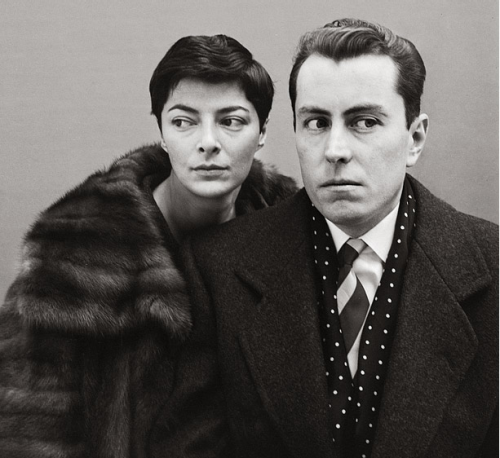The photographer I chose this week is Berenice Abbott. This Ohio native is best known for her architectural photographs from the 1930's NY urban scene. I was a little bit confused as to what POINT OF VIEW actually meant within the context of a photograph. So, I kinda of just based it on the focal points being somewhat in the distance or through a tunnel of things that compositionally, caught my eye.
Cliff and Ferry Street. 1935.
I love how you can see the building in the distance, through the mist. The cropping makes the eye go up and down appreciating every detail rapidly. The streets are interesting, as well as the transportation methods. It kind of reminds me of that one scene in Inception where Ellen Page distorts the bejeezus out of the a dream, making the horizon curve up like a wave, placed on top of them as the sky. The building in the distance is either really cool and has a base and a tower with different colors or its just 2 separate buildings in front of another.
Woman on Steps. Baltimore, Maryland, 1954
The repetitious sets of perfectly alined marble slabbed stairs vanishing into the distance creates unity and balance. Brick house exteriors are all parallel lines that make encourage your eye to move further into the depth of the image as well as the lines in the gridded plane on the cement sidewalk. Maids cleaning and sweeping [there's 2 of them and they're both working on similar tasks... balance.] An almost surreal photograph when taking into consideration it's element's placement and inter-relationship to one another. Exquisite shot, in my opinion. 40th Street between Sixth and Seventh Avenues. 1938
This captivating photograph was the first one to grab my attention as I skimmed through many of her photographs. The clean edges express light and shadow, the sky holds on to a gray mid-tone complements the harsher black in the shadows of the building. I really like the shadow the drops down from the water container on the bottom right corner because it hovers in a wall with no windows which makes for a great spotlight. From a distance, it is almost a gradient going from black to white, coming from the bottom left corner to the upper right corner. I wish I could've seen more of the sky above the buildings, but all of the angular contrast of squares makes up for it.
Houses. Stonington, Maine, 1967
The first thing I saw in this was the post with the cables almost shining away from it. A focal point, in deed. The angles on the rooftops help the composition flow outward from the culminating point that is the pole. I like the integration of man on nature and how this would've been a beautiful landscape but we have al of these wires and wooden panels and nails and concrete... all of them derivate from nature itself but discordant, none the less. The houses do look interesting, very small and upright, 2 toned, very simple.
And this shizzzzzzzzzzznit is amazing! A beautiful crop with building shadows on the middle of the street with a lovely view of the ridge between the 2 edifices. The contrast on the buildings themselves really pushes the eye to ingest every detail with ease. There's a light post you can see underneath the bridge that for some reason, I really enjoy. Maybe its, shape and form, its dark and slim contrast on a foggy light background... I don't know, but it fascinates me. Great choice of weather and time of day by the photographer.







